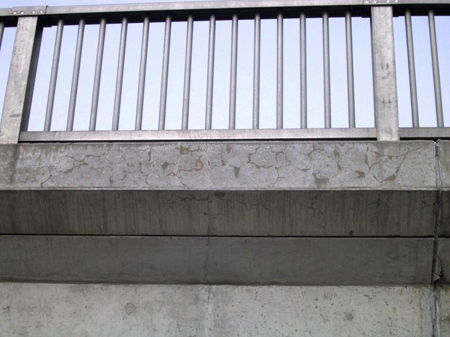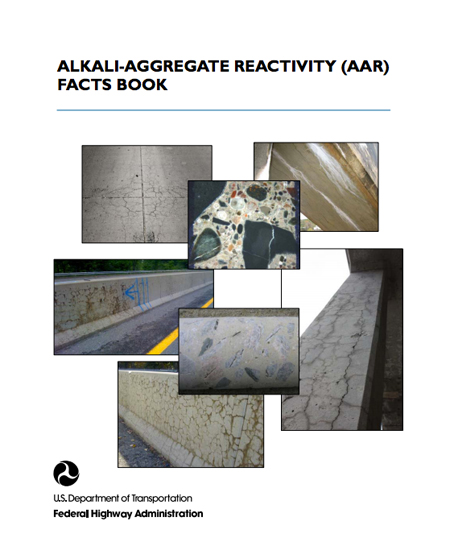U.S. Department of Transportation
Federal Highway Administration
1200 New Jersey Avenue, SE
Washington, DC 20590
202-366-4000
Focus
| Accelerating Infrastructure Innovations |
Date: October 2013
Printable Version (.pdf, 0.3 mb)
Get the facts on alkali-aggregate reactivity (AAR).
AAR in concrete structures and pavements can occur as both alkali-silica reaction (ASR) and alkali-carbonate reaction (ACR). The Federal Highway Administration's (FHWA) new Alkali-Aggregate Reactivity Facts Book (Pub. No. FHWA-HIF-13-019) discusses both types of reaction but concentrates on ASR, as cases of ACR are more limited.
"Developed as part of FHWA's effort to deliver training to States, the Facts Book is designed to serve as a reference document containing detailed information on AAR," said Gina Ahlstrom of FHWA.
ASR occurs when silica in some aggregates and alkalis in concrete combine with water to form a gel-like substance. As the gel absorbs water and expands, it can cause the concrete to crack. Over time, the cracks enable other forms of distress to occur, such as freeze-thaw damage or corrosion. This can lead to premature deterioration and loss of service life for concrete pavements and structures. Problems caused by ASR were first identified in California in the 1930s, with ASR now recognized as a major cause of concrete deterioration worldwide.
The Facts Book offers background information on the chemical reactions that cause ASR, as well as discussion of the symptoms of ASR, test methods for detecting it, mitigation methods, and preventive measures, including avoiding reactive aggregates and controlling the concrete's alkali content. Also discussed are specifications that address ASR, including the American Association of State Highway and Transportation Officials (AASHTO) specification, AASHTO PP65-11, Standard Practice for Determining the Reactivity of Concrete Aggregates and Selecting Appropriate Measures for Preventing Deleterious Expansion in New Concrete Construction.
Practitioners can also find guidance on managing pavements and structures affected by ASR. A confirmed diagnosis as to the presence and extent of ASR requires laboratory testing and petrographic examination of concrete cores. By combining the results of the laboratory investigation and the symptoms observed in a site investigation, transportation agencies can determine the likely contribution of ASR to the observed damage.
ASR mitigation methods are described, including options that have been used most frequently and those whose effectiveness has been proven in the laboratory and the field, versus measures that remain more experimental. Mitigation measures generally cannot repair or restore an ASR-affected structure, but they can reduce future expansion of the structure or lessen the impact of future expansion. Among the most effective mitigation measures have been the application of coatings and sealers such as silane to reduce the internal relative humidity in the concrete and slow the progression of ASR.
Information can also be found on ACR. This reaction, which involves alkali hydroxides in the concrete and certain types of carbonate rocks present in some aggregates, can also result in the expansion and cracking of concrete elements. The Facts Book discusses the chemistry of the reaction, mechanisms of expansion, contributing factors, and differences between ACR and ASR. Generally measures that have been effective in reducing concrete expansion caused by ASR do not work for ACR. To prevent ACR from occurring, AASHTO specification PP65-11 includes procedures for detecting and avoiding the use of alkali-carbonate reactive rocks.
To download the Alkali-Aggregate Reactivity Facts Book, visit www.fhwa.dot.gov/pavement/pub_details.cfm?id=894. For more information on AAR, contact Gina Ahlstrom at FHWA, 202-366-4612 (email: gina.ahlstrom@dot.gov). Additional resources on ASR can be found at FHWA's online ASR Reference Center at www.fhwa.dot.gov/pavement/concrete/asr.cfm. The center contains more than 300 specifications, guidance documents, reports, test methods, and other references on ASR.

This concrete highway barrier is affected by ASR.

The edge beam supporting this bridge railing has minor ASR-related cracking.
